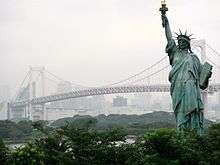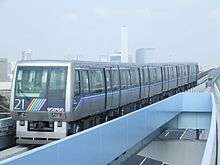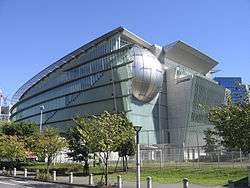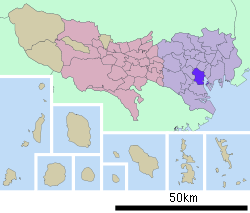Odaiba
Coordinates: 35°37′48″N 139°46′30″E / 35.63°N 139.775°E
Odaiba (お台場) is a large artificial island in Tokyo Bay, Japan, across the Rainbow Bridge from central Tokyo. It was initially built for defensive purposes in the 1850s, dramatically expanded during the late 20th century as a seaport district, and has developed since the 1990s as a major commercial, residential and leisure area. Odaiba, along with Minato Mirai 21 in Yokohama, are two of the only places in the Greater Tokyo Metropolitan area where the seashore is accessible, and not blocked by industry and harbor areas.
Daiba (台場) formally refers to one district of the island development in Minato Ward. The Odaiba name is commonly used to refer to the entire Tokyo Waterfront Secondary City Center (東京臨海副都心 Tōkyō Rinkai Fukutoshin) which includes the Ariake and Aomi districts of Kōtō Ward and the Higashi-Yashio district of Shinagawa Ward.
History
The name Odaiba comes from a series of six island fortresses constructed in 1853 by Egawa Hidetatsu for the Tokugawa shogunate in order to protect Edo from attack by sea, the primary threat being Commodore Matthew Perry's Black Ships which had arrived in the same year.[1] Daiba in Japanese refers to the cannon batteries placed on the islands. In 1928, the Dai-San Daiba (第三台場) or "No. 3 Battery" was refurbished and opened to the public as the Metropolitan Daiba Park, which remains open to this day.


Of the originally planned 11 batteries, only five were ever finished. The modern island of Odaiba began to take shape when the Port of Tokyo opened in 1941. Until the mid-1960s all except two batteries were either removed for unhindered passage of ships or incorporated into the Shinagawa port facilities and Tennozu island. In 1979 the then called landfill no. 13 (now Minato-ku Daiba, Shinagawa-ku Higashi-Yashio and Kōtō-ku Aomi districts), was finished directly connecting with the old "No. 3 Battery". "No. 6 Battery" was left to nature (landing prohibited).
Tokyo governor Shunichi Suzuki began a major development plan in the early 1990s to redevelop Odaiba as Tokyo Teleport Town, a showcase for futuristic living, with new residential and commercial development housing a population of over 100,000. The redevelopment was scheduled to be complete in time for a planned "International Urban Exposition" in spring 1996.
Suzuki's successor Yukio Aoshima halted the plan in 1995, by which point over JPY 1 trillion had been spent on the project, and Odaiba was still underpopulated and full of vacant lots. Many of the special companies set up to develop the island became practically bankrupt. The collapse of the Japanese asset price bubble was a major factor, as it frustrated commercial development in Tokyo generally. The area was also viewed as inconvenient for business, as its physical connections to Tokyo—the Rainbow Bridge and the Yurikamome rapid transit line—made travel to and from central Tokyo relatively time-consuming.
The area started coming back to life in the late 1990s as a tourist and leisure zone, with several large hotels and shopping malls. Several large companies including Fuji Television moved their headquarters to the island, and transportation links improved with the connection of the Rinkai Line into the JR East railway network in 2002 and the eastward extension of the Yurikamome to Toyosu in 2006. Tokyo Big Sight, the convention center originally built to house Governor Suzuki's planned intercity convention, also became a major venue for international expositions.
The D1 Grand Prix motorsport series has hosted drifting events at Odaiba since 2004.
Odaiba is one of the venue locations in the upcoming 2020 Summer Olympics. The events to be held there under the venue plan include beach volleyball at Shiokaze Park, triathlon and marathon swimming at Odaiba Marine Park, and gymnastics at a new gymnastics venue.[2]

Attractions

Today's Odaiba is a popular shopping and sightseeing destination for Tokyoites and tourists alike. Major attractions include:
- Palette Town:
- Daikanransha, a 115-metre (377 ft) Ferris wheel
- Megaweb, exhibition hall of car maker Toyota
- Tokyo Leisure Land, 24-hour video gaming, karaoke, bowling
- Venus Fort, a Venice-themed shopping mall
- Zepp Tokyo, one of Tokyo's largest performance halls/nightclubs
- Fuji Television studios with a distinctive building designed by Kenzo Tange
- Miraikan, Japan's National Museum of Emerging Science and Innovation
- Rainbow Bridge connecting Odaiba to the heart of Tokyo
- Tokyo Big Sight Tokyo International Exhibition Center
- Aqua City shopping center
- Diver City shopping center
- Gundam Front Tokyo, featuring an 18 meter tall Gundam statue[3]
- Zepp DiverCity
- Decks Tokyo Beach shopping mall, featuring Sega Joypolis and Little Hong Kong
- Museum of Maritime Science (Fune no kagakukan) with swimming pool
- Oedo-Onsen-Monogatari sentō
- Shiokaze park with BBQ places and Higashi Yashio park
- Telekom Center Building (MXTV's former headquarters) with observation deck
- One of two beaches in urban Tokyo (swimming prohibited), along with Kasai Rinkai Park in Edogawa Ward
- A replica of the Statue of Liberty
- Panasonic Centre, a science and technology showroom
Transport

Two Shuto Expressway lines access Odaiba: Route 11 enters from central Tokyo crossing the Rainbow Bridge, while the Wangan Route enters from Shinagawa Ward through the Tokyo Port Tunnel and from the bayfront areas of Tokyo and Chiba Prefecture to the east.
By public transport Odaiba is accessible via the automated Yurikamome transit system from Shimbashi and Toyosu. The privately operated Rinkai Line runs between Shin-Kiba and Ōsaki but many trains connect directly to Shibuya, Shinjuku, and Ikebukuro. City buses provide cheaper if slower access. Ferries connect Odaiba with Asakusa running along the Sumida River and the Kasai Rinkai Park in eastern Tokyo.
Cultural references
Odaiba, The Rainbow Bridge, and other parts of the surrounding area are referenced in the Digimon Adventure franchise. The area is noted in many major areas of the plot.[4][5][6][7][8][9][10]
References
- ↑ The architecture of Tokyo Hiroshi Watanabe p.143
- ↑ "Venue Plan". Tokyo 2020 Bid Committee. Retrieved 8 July 2013.
- ↑ "Giant 60-Foot 'Mobile Suit Gundam' Statue Presides Over DiverCity Tokyo Plaza (PHOTO)". The Huffington Post. 2012-05-01. Retrieved 2015-05-11.
- ↑ "Odaiba - Shiria-mae Crossing". marron.extracaffeine.com. Retrieved 2015-12-15.
- ↑ "Odaiba". marron.extracaffeine.com. Retrieved 2015-12-15.
- ↑ "Odaiba". marron.extracaffeine.com. Retrieved 2015-12-15.
- ↑ "Odaiba". marron.extracaffeine.com. Retrieved 2015-12-15.
- ↑ "Odaiba". marron.extracaffeine.com. Retrieved 2015-12-15.
- ↑ "Odaiba - Dai-san Daiba/Dai-roku Daiba, Daibakōen". marron.extracaffeine.com. Retrieved 2015-12-15.
- ↑ "Odaiba". marron.extracaffeine.com. Retrieved 2015-12-15.
External links
| Wikimedia Commons has media related to Odaiba. |
| Wikivoyage has a travel guide for Tokyo/Odaiba. |
- Area Guide of Odaiba with sightseeing spots
- historical map from 1892 (in Japanese)
- Fuji-TV Odaiba Live Camera - YouTube



